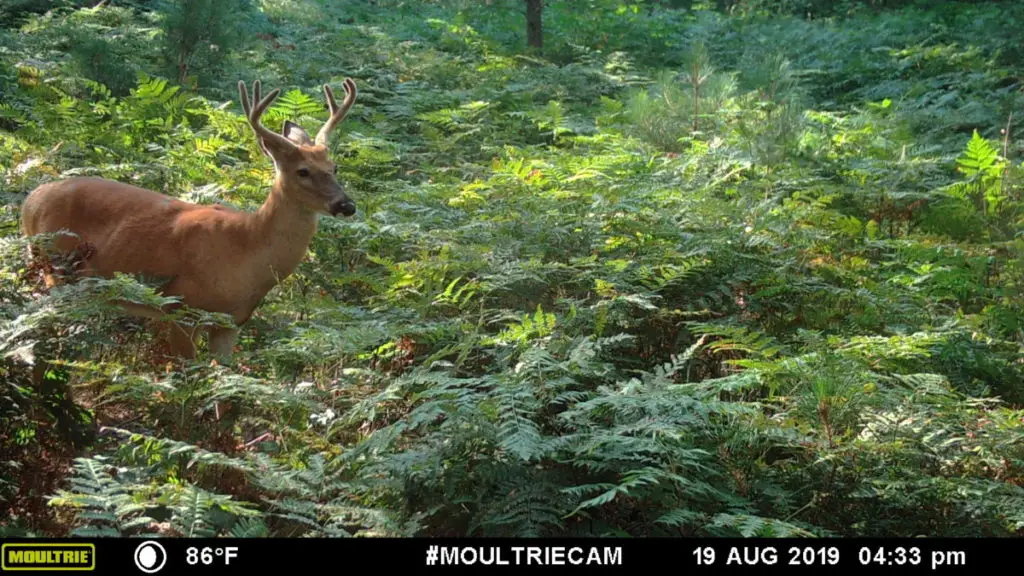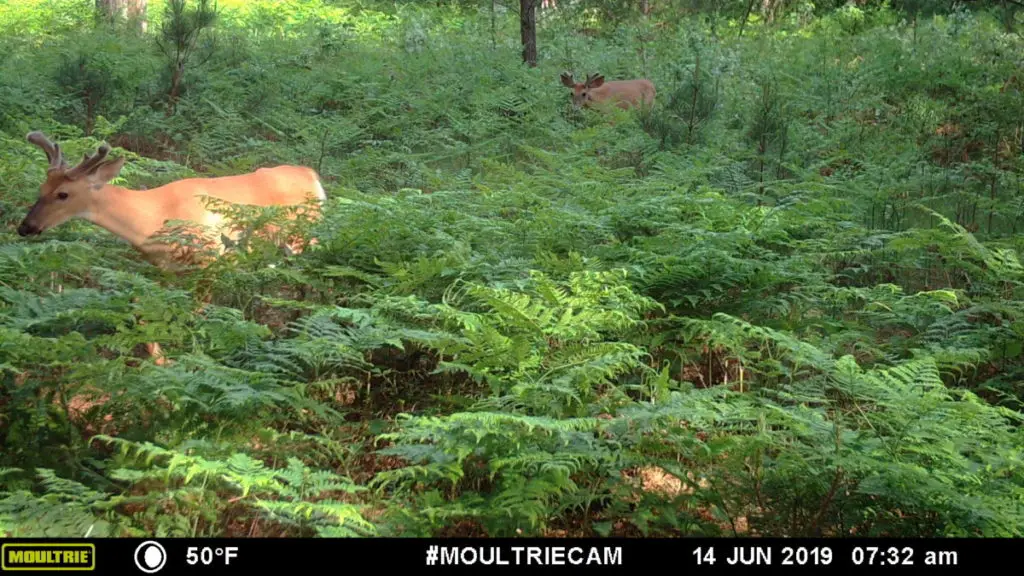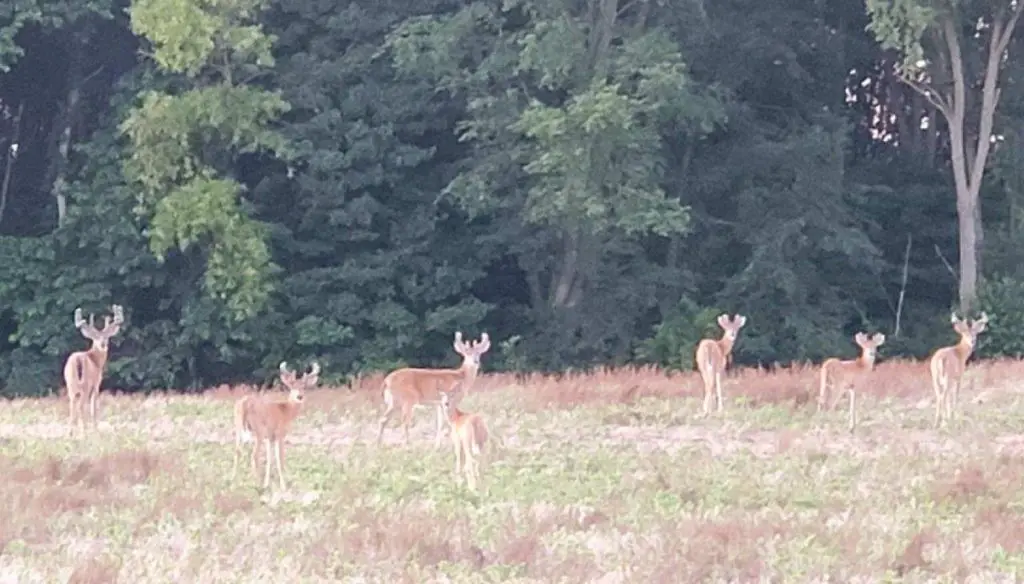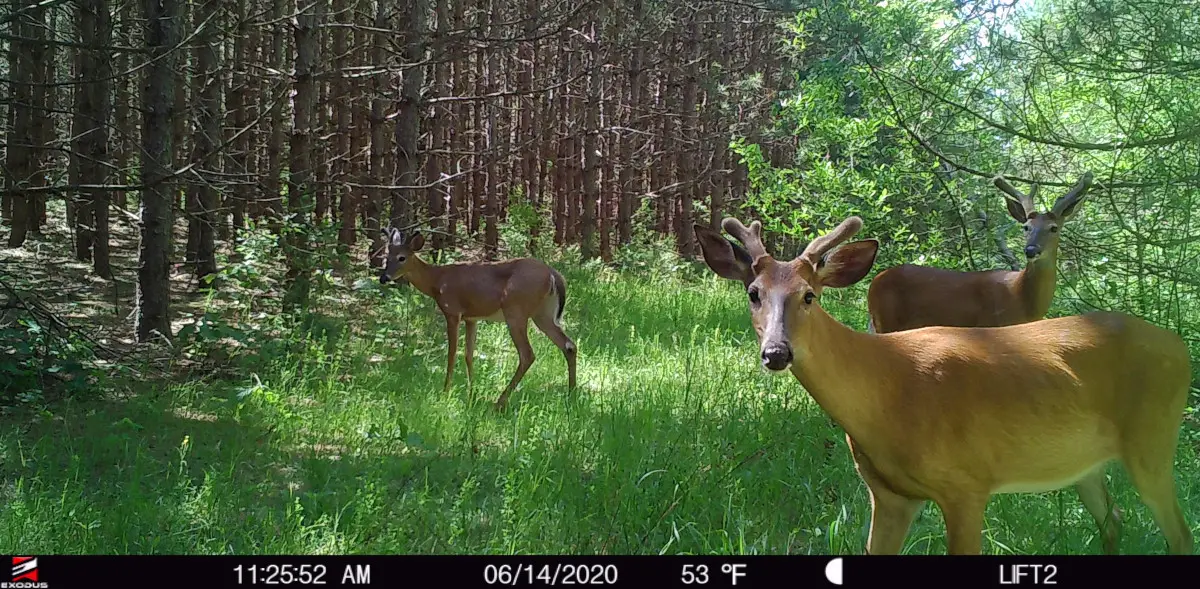You would be hard pressed to find a more exciting time to run trail cameras than during the whitetail antler growing season. From the first little bump of velvet in the spring until the full formed antlers in late fall, you can literally watch from week to week as their antlers grow.
For some, however, finding bucks donning velvet can seem more like an urban legend. You hear about it, hear others discuss it, and probably see pictures of them flanking your social media feed, but the trail camera photos you are getting, just isn’t producing the same results.
The reason is very simple, it all comes down to focusing your trail camera on very specific locations.
The trick to getting more photos of bucks in velvet is to focus your trail cameras on three specific locations: Food sources, bedding areas, and watering locations. In the summer, deer move on strict patterns, spending 90% of their day in these three locations.
Lets break down these three locations and how to target them better with your trail camera.
Food Sources
During the late Spring and into the summer, deer are in need of one thing, rich protein food sources. A high protein diet, not only helps them recover from a tough winter, but also helps with the growth of fawns, and of course the growth of antlers.
The key is to locate and identify these specific food sources.
Farm Fields and Food Plots
If you drive down any dirt road in America at dusk, it is no surprise when you see a field full of deer. These farm fields are filled with high nutrient food that is needed for antler growth. Alfalfa, clover, chicory, and a variety of grasses are all common targets for bucks, as they are high in protein content.
Camera Setup
Setting up trail cameras on these locations can be tricky however. With a vast amount of land that a farm field, and even food plots, provide, makes camera placement critical. You have basically two options in these locations.
The first option is to find a high point along the edge of the field that has a good vantage point. By setting a camera in this location, you can utilize the often overlooked feature of your camera: the time lapse mode. Setting your time lapse to take a picture every few minutes around dusk and dawn, will give you an incredible opportunity to capture photos of almost every buck that visits the field.
The downside to using this option however is your photos will likely be of deer at quite a distance, making it difficult to really see the growth of the antlers. You can however use the time lapse mode to locate enter and exit locations to the field, nicely setting yourself up for option number two.
The second option for hanging a camera on a field edge is to locate the entry and exit points into the field. Deer trails, tracks and adjacent cover are all good places to begin to locate. In the summer months, deer, and bucks in particular are not isolated animals, so the more sign of deer traffic the better chances you have of picking up a buck strolling through.
In these situations, I recommend setting your camera on a higher burst count, with a quicker recovery time. As deer filter into the field, they typically do so in small groups, making a quick recovery time on the trail camera vital for catching each deer.
Mineral Stations
In states and regions where it is legal, bait stations are incredibly effective for attracting deer during the summer antler growing season. While there is an incredible debate on whether mineral does in fact help the growth of antlers, there is no denying that it is an attractant.
Camera Setup
There are two important factors in setting a camera up on a bait station:
- Place a camera higher into the tree, and point it down toward the mineral station. This helps with eliminating the amount of false triggers that you will get with grass growing around the camera.
- Set your trail camera to lower photo count, with a longer delay. With mineral stations, deer tend to loiter around for quite some time. While it is nice to see a doe with fawns visiting the site, you don’t want to fill your SD card with thousands of photos of the same 3 deer.
Buds, Berries and New Growth

Many of us do not have access to farm fields, and with the growing concern of CWD, bait stations are becoming increasingly banned in many states. With this being the case, most of us must rely on natural browse to locate a buck’s food source. While this can become more labor intensive to find, the results are usually more daylight photos as natural browse is typically found near or around security cover, making the deer more apt to feed during the day.
Especially in the spring months, deer will focus on buds of a sapling’s new growth. Buds often are filled with high nutritional value for a deer, as the plants are focusing all of the nutrients it gets from the ground toward growth. Deer will nip the ends of these buds off the trees as they become available.
Berries are another great food source for deer, especially in mid summer. Wild strawberries, raspberries, huckleberries, and grapes, when ripe will all attract deer, much more consistently than even a farm field. The sweet flavor is a palate favorite of deer.
The final location I focus on is new growth areas in clear cuts. These locations are gold mines for finding mature deer within the timber during the summer months. Low hanging leaves and new growth shoots, not only provide a viable food source, but are also a great security cover that promotes day light feeding.
Camera Setup
These locations are unique in the fact that you can choose which ever settings on your camera that you like the best. If you are a big fan of video, run video. If you enjoy having a high quality photo, you can set your camera up for this as well. While deer may linger around these locations for a while, they typically will not stand in one spot like a mineral station, so utilizing a higher burst count, will likely not load up your SD card with unwanted photos.
Water Locations
During the summer months the weather can get hot (no kidding right). But, deer, just like us, when the temperature rises, they need to consume more water to stay hydrated. This makes water sources a go to location for finding velvet bucks.
Creeks, ponds, and lake edges are all great locations for deer to get a much needed drink.
Camera Setup
The biggest key to setting up a camera on water sources is to locating where they are accessing the water. A pond might be simple, by just finding a few tracks or a trail that leads to the water, while a creek might require a place where a down tree allows the water to pool up a bit.
Once you find the location, for me choosing the settings on the camera is very simple, I always use video mode. Deer will not stay at watering holes for too long. They typically grab a drink and go on their way. There is so much more you can see from a video, than you would get from a few quick photos, that makes this option very simple.
Bedding Areas
If you are a hunter, you know the importance of finding a well used bedding area, as during daylight hours, deer spend the majority of their time here. Summer bedding, however, can be much different than fall bedding, as the time of year, and the weather conditions play a huge factor in when and where they desire to bed.
Here are some major differences of where bucks choose to bed in the summer months:
- They need overhead cover– while during the fall months, bucks will bed in nearly any situation, including tall grasses in the middle of a CRP field. During the summer months, just like us, they need shade to keep themselves cooler. While they will still bed out in the middle of a cattail marsh, they need some sort of overhead cover to protect themselves from the sun.
- They bed closer to food sources- Very similar to the winter, bucks will find themselves bedding closer to destination food sources. Just like in the winter, this is a result of conserving energy. With less human pressure on the area during the summer, bucks will find it beneficial to locate their bedding areas closer to these food sources.
- Less stem count areas- As bucks begin to grow their velvet antlers, there is one thing that is overlooked; how sensitive the antlers are to the touch. As long as there is less pressure to an area, bucks will choose to bed in areas that are not as thick in cover to avoid bumping their newly formed head gear. Now let me be clear, I am not saying that bucks wont bed in thick cover during the summer, but given the opportunity they would much rather avoid squeezing into high density areas with sensitive antlers.
Some of the most fruitful bedding areas I have found during the summer is rowed pine plantations, where there is isolated pockets of undergrowth. These areas provide both overhead cover as well as lower density security cover. If you can find these locations that are adjacent to good quality food sources it is almost assured there will be a buck bedding in the area.

Camera Setup
Any time you hang a trail camera around a bedding area, it can be a tricky situation. If you get too close, you run the risk of spooking them out of the area. If you hang your camera too far away, it is less likely that you will get consistent photos during daylight. Not to mention the problems you will have with infrared flash, access routes to check the camera, and dominate wind directions and thermals. There is a lot to consider, but here are the steps I go through once finding a summer bedding area.
- Understand their entry an exit routes- With every deer bedding area there is at least one primary entry and exit route, and quite often there is multiple. Figuring out the landscape of the area, and determining where the bucks want to go, is a key to trail camera placement.
- Find a location outside the immediate bedding area- Once you understand how the buck is using the bedding area with entry and exit routes, its quite easy to back off the actual bed, and find a location that he will use on a regular basis. You don’t need to be 300 yards from the bed to set a camera, but you want to make sure that you are also not putting the camera directly over the bed.
- Determine a good entry route- Understand how the wind typically moves through the area, and how the thermals work for a specific bed. This all plays into a good strategy of not spooking the deer out of the area. Once you figure out how the air currents work in this area, determine a specific entry and exit route into your camera where your scent will not blow into the bedding area.
- Only use true no glow trail cameras- A deer’s bedding area is a secure place for a buck, and any strange sights, or noises will be immediately noticed. While the science of whether deer can see the infrared glow from a camera is unclear, don’t take any chances and use only no glow cameras in these areas.
- Hang the camera high- Similar to the same reasons you would use a no glow camera, you want to make sure you keep the camera out of the sight line of the deer. Deer will notice a camera at eye level, so, don’t take the chance and keep the camera out of sight.
- Use video mode- while you could use any configuration of trail camera settings in these locations, I always use video mode. If you want a lesson in how deer leave a bedding area, their mannerisms, their cautious behavior, their attention to details of the surrounding area, you can learn all of this from a video. A few pictures tells you he is there, but a video will give you incredible insight as to exactly how he uses the area.
Bachelor Groups

One of the main reasons it is more difficult for some to get velvet bucks on their trail camera is due to the herd dynamics during summer months. In the fall, bucks tend to be isolated animals. Due to this behavioral trait, it is common to at least get one or two bucks to pass by a camera. In the summer, bucks herd up with other bucks in what is known as bachelor groups.
Bachelor groups are when multiple bucks herd up, in at least pairs, but often in groups as many as 6 or more. The dynamics of these groups are fascinating, as even without fully formed antlers, they begin to create a hierarchy among each other. There is a determination of which buck is the dominate buck in an area, and the subordinate bucks fall in line.
Once their antlers begin to harder, and they shed their velvet, most often these bachelor groups disperse and bucks will travel back to their fall home range.
For this reason, if you are not getting multiple bucks on your trail camera, you are likely not getting any. It is important to find the areas in which these bachelor groups range during the summer months. You can find this by either casting a large net of trail cameras, or simply by driving around your area in the evenings to locate these groups feeding in fields. Either way, if you want more pictures of velvet bucks on trail camera, you need to locate bachelor groups, and move to where they are.
What Pictures of Velvet Bucks Can Tell You
Often you will hear trail camera users talk about how they are on a big buck in mid July. While they are undoubtedly getting pictures of mature deer, what does capturing photos of these deer in the summer really tell you?
The truth is, it can tell you everything you need to know, and at the same time could be telling you nothing at all. It all comes down to how well you know your hunting property. When bucks disperse from bachelor groups in the late summer months, particular deer can travel as far as 10 miles from their summer locations. At the same time, some bucks from their bachelor group might stay in very similar patterns as they do during the summer. Everything depends solely on how attractive their summer range is during the fall.
One thing we can all count on, is that if you are getting a large buck on camera during the summer months, we know he is alive, and now the work begins to find his fall and winter range. If you are hunting public land, you likely have more area available to cover in order to find him. Conversely, if you are hunting in an area will small blocks of private land, you might need to start knocking on doors to gain permission in order to find him.
Whatever the case may be for you in the fall months, finding mature deer growing antlers in the summer months, raises your excitement level to a new level. Finding these bucks and watching them grow can be one of the most fun times to run trail cameras.

